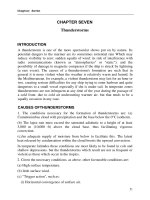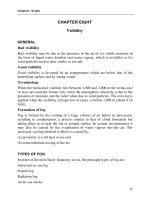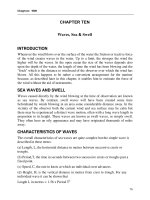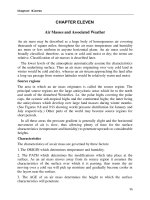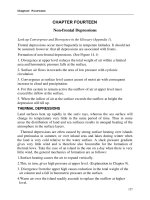BÀI GIẢNG KHÍ TƯỢNG LÝ THUYẾT CHƯƠNG 2
Bạn đang xem bản rút gọn của tài liệu. Xem và tải ngay bản đầy đủ của tài liệu tại đây (50.48 KB, 3 trang )
Chapter two
CHAPTER TWO
Solar Radiation and Temperature
Radiation is a form of heat transfer which is completely independent of
the medium through which it travels. All bodies. whatever their temperature,
emit heat energy in the form of short electromagnetic waves which travel
through space at the speed of light. The actual wavelength depends on the
temperarure of the radiating body. The hotter the body the shorter the wavelength and the more intense is the emission. At very high temperatures a body
emits both heat and light. e. g. a tire. The surface temperature of the Sun is
something in the nature of 6.000oC.
Of the Sun's radiant energy which strikes the Earth much is absorbed,
thereby increasing the temperature of the surface which emits long invisible
heat waves back into space. Some of the incoming short-wave radiation from
the Sun is lost through absorption. ret1ection and scattering by cloud. A thick
cloud will reflect nearly 80 per cent of the radiation which it receives.
Absorption is ,very little, probably about seven per cent.
water vapour and cloud. when present. strongly absorb most of the
outgoing longwave radiation. some of which is re-radiated into space and
some re-radiated downwards to the Earth's surface. and thus compensating in
some measure for loss of heat by outgoing radiation. This is called the
greenhouse effect. It explains why. when there is a thick cloud layer at night.
the fall in surface temperature during the hours of darkness is less than on
nights when there is a clear sky allowing free terrestrial radiation.
DIURNAL RANGE OF SURFACE TEMPERATURE
Soon after sunrise the incoming short-wave energy begins to exceed the
outgoing long wave emission. The temperature of the surface then starts to
increase anti generally reaches its maximum by about 1400 hours. Local
Time. after which it gradually begins to cool. All incoming radiation ceases
when darkness falls and the surface continues cooling through the night until
sunrise when the whole cycle is repeated.
Bodies which are good absorbers of heat are also good radiators and the
converse is true. In general. land may be described as a strong absorber by
comparison with a water surface which is relatively very weak. Thus the
diurnal range in temperature of a land surface is much greater than that of the
sea surface which, in ocean areas. is generally less than 0.5°C (the interior of
7
Chapter two
continents may vary by 16°C (30°F) or more). The general pattern of diurnal
variation in land temperature is often modified locally by weather. For
instance, a change in wind direction might bring a much colder or warmer
airstream into the region.
FACTORS AFFECTING
RADIATION
THE
HEATING
EFFECT
OF
SOLAR
1. The inclination of the solar beam to the Earth's surface. This depends on:
(a) The latitude of the place.
(b) The Sun's declination which varies with the seasons. (c) The
daily change in the Sun's altitude.
In Figure 2.1. ER represents a portion of the Earth's surface. X and Y are
two solar beams of equal intensity and having the same cross-sectional area.
Beam X is directed at an oblique angle to the Earth's surface and its energy is
spread over a relatively large area AB. Beam Y is nearly vertical to the surface
and its radiation is concentrated onto the relatively small area CD. The pecked
line FGH represents the upper limit of the atmosphere, from which it can be
seen that the beam X has to pass through a greater thickness of atmosphere
than beam Y before reaching the Earth, and so will suffer a greater loss of
energy due to reflection and scattering. Thus, all other things being equal. the
heating effect will be greatest at area CD.
2. The nature of the surface. Snow and ice surfaces reflect about 80 per cent
of the radiation received. Dry soil, bare rock and sand, though poor
conductors of heat, are very good absorbers and the heat energy received
penetrates only a very shallow layer of surface amounting to a few inches.
8
Chapter two
Hence a relatively high rise in temperature for a given amount of radiation.
By contrast the temperature of the sea surface changes only a very little for
the same amount of heat energy. The reasons for this are:
(a) The specific heat* of water is much greater than that of land.
(b) The solar rays penetrate the sea surface to a depth of several metres.
(c) The stirring effect of the wind brings up colder water from below.
(d) Much of the heat received by the sea surface becomes rapidly used
up in the process of evaporation.
(e) A water surface reflects solar radiation, especially at large angles of
incidence.
Air temperature near the surface tends to follow that of the surface below.
Thus the annual range. like the diurnal range, is greater over the interior of
large continents than over the oceans. The main factors governing air
temperatures at sea are:
(a) Latitude. Generally warmest within the tropics and sub-tropics.
(b) Season.
(c) Proximity to large land masses.
(d) Prevailing winds.
(e) Ocean currents.
(f) Upwelling of cooler water from the depths.
(g) The presence of ice or snow covering.
* The specific heat of a substance is the number of joules required to raise the
temperature of that substance by 1oC. The specific heat of water is higher than that of
any other common substance. Hence the gain or loss of a given quantity of heat brings
about a smaller change in temperature of sea than of land.
9

